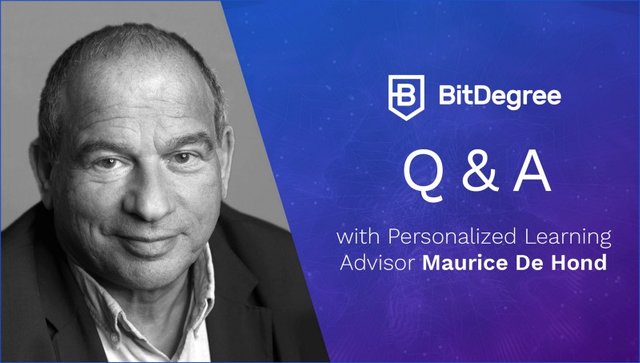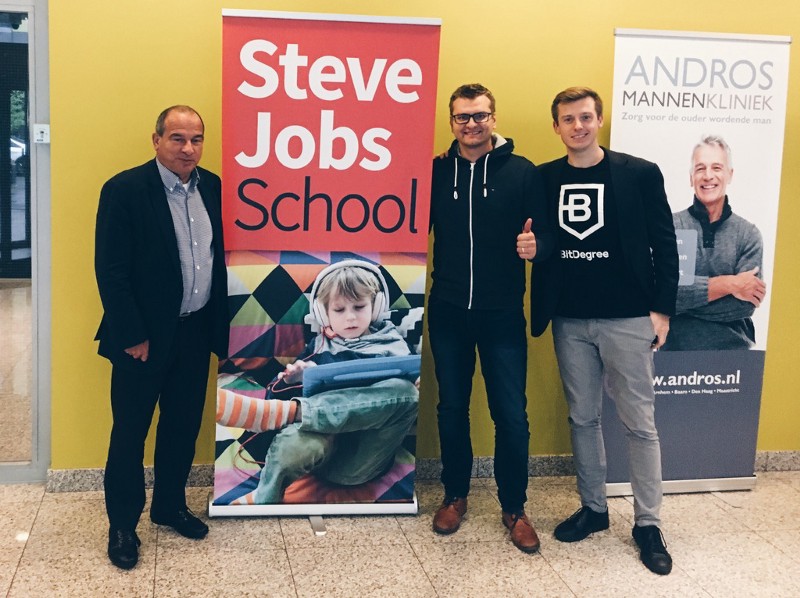Steve JobsSchool Founder Joins BitDegree as Personalized Learning Advisor
Maurice de Hond is the latest international advisor to join the BitDegree team ahead of its token sale beginning on December 1st, 2017. He is BitDegree’s Personalized Learning Advisor. An innovator with over 50 years of experience in technology and education, de Hond is also the founder of the Netherlands-based Steve JobsSchool, which was nominated by Tech Insider as one of the most innovative schools in the world thanks to its revolutionary approach to individualised learning.
“I joined BitDegree because I was attracted to its team’s revolutionary approach of solving the problem of educational institutions failing to prepare students with the necessary applicable skills they need to succeed when they enter the world of work (or find a job),” explained de Hond. “I believe BitDegree’s philosophy of rewarding students with tokens will encourage its students to find, and stick with, a course of study that is right for them.”
Further BitDegree advisors with experience in international technology, business, and education will be announced in due course.
Electronic Arts co-founder, Jeff Burton, joined the team in September 2017.
BitDegree: Why did you decide to join BitDegree?
Maurice de Hond: I was attracted to BitDegree because I am interested in technology and how it can be applied to different parts of society. I was attracted by the team’s revolutionary approach of combining education and modern technology to encourage students to begin a course and finish it by rewarding them with tokens. I would say that I am mostly attracted to the innovative angle they are taking towards solving the problems that face current education systems.
How do you see your experience as an innovator and at the SteveJobs school being applicable to BitDegree’s goals?
I believe I am able to help BitDegree in achieving its goal of revolutionising education because I have experience in connecting content to targets. I also have over 40 years of experience of assisting companies in keeping focused on their targets of solving problems for customers, and not just being enthusiastic about the technology they use in doing so.
What was your motivation in creating the Steve JobsSchools in the Netherlands?
The motivation behind the Steve JobsSchools was my two children. I have one daughter who was born in 2009. My son was born in 1977. They grew up in two different worlds, especially with regards to technology. By the time my daughter was two years old, she already worked with an iPad. I found it difficult to understand that if I wanted to prepare my daughter for adult life after the year 2030, then I would have to send her to the same school I sent my son to 30 years earlier. I came to the conclusion that schools prepare nowadays children for the past and not the future.
What do you see as the biggest flaws in the current education system at present?
There are a number of flaws, but I would narrow it down to three big issues: curriculum, social construct, and an outdated school model.
Since the boom of the Internet and mobile devices, our relationship with information and knowledge has changed a lot in comparison to the past. Meanwhile, the curriculum in schools is largely the same as it was decades ago despite the world going through the biggest ever revolution with regards to information and communication. However, it’s almost as if it this completely bypassed governments who are responsible everywhere for national curricula.
The second point is context and social construct, because children who were born in the 21st century live within a completely different context and social framework to those born even one or two decades previously. I was born at a time before television was invented, and I didn’t know what was happening in my own city. Today it is possible to find out what is happening anywhere in the world at any time with the push of a button.
When I was growing up, everybody had more or less the same social experiences, and this made us more or less the same. Thanks to technology making the world smaller, we are easily able to meet people with different experiences to our own. I always use the following example of two children; one of whom was born in the Amazon rainforest, and the other was born in New York. After 10 years, they will be completely different in terms of what they know, and what they are able to do. I look at my daughter born in 2009, and my son born in 1977 and I see them as these two children in terms of the world in which they grew up.
The third problem is that the ‘traditional’ model of schooling is still firmly rooted in the 19th century. It’s very industrial because it is based on a “one size fits all” philosophy, with one teacher to around 30 to 50 children. Nowadays, this approach does not work well because the demands on personal knowledge are so diverse, it does not fit within children’s current social frameworks, and it does not prepare children for what they will find when they are going to work in the future. And with the help of technology there are other ways of organising of the school possible.
Moreover, adults are not aware of this “perfect storm” because their children’s experience at school is similar to what they experienced. Adults are conditioned in schooling methods of the past, and they are not aware of this. Therefore, they are satisfied to see their children learn the way they did, even though their own lives and social contexts are completely different of that of their own parents..
How do you think students will be learning within the next decade or 15 years or so?
Unfortunately, I fear many of them will still be learning using old methods. It is important to remember that people are generally conservative by nature, and education systems all over the world are almost completely dictated by government decisions. The pace of change also slows down when a government needs to decide to change something. Whilst I don’t think much will change over the next 10 years, I believe that more and more people will begin to realise that the diploma you receive when you finish your course of education will mean increasingly less. Employers are showing more and more interest in what you know and how you apply it, instead of what you actually studied. This is because much of what is learned in relation to work in the future is learnt not in school, but is instead learnt out of the classroom such as online, or through other experiences. In my opinion, this is why ‘traditional’ schooling is becoming increasingly irrelevant for those who were born in the 21st century.
In your opinion, what are the benefits of personalised learning?
The main benefit of personalised learning is being connected to what you already know, and how you learn. This is then tied into the school’s programme. This makes it the complete opposite to the “one size fits all” approach. Thanks to technology, and if it is used in the right way, then you use it to tap into a child’s talents, through tailoring it to the world they live in, and thus their capabilities. To simplify it, cars on a assembly line 40 years ago were all the same. With the use of technology each car in the same assembly line can be different in important details.
Do you believe that personalised learning is the way forward for the future of all education systems?
Yes, I do. I also believe that the “one size fits all” does not meet 21st century demands. In most of the 20th century, “one size fits all” was very useful because one teacher to a large number of children worked. This is due to education then (and now) being based on the “just in case” philosophy. Governments and communities assumed that a pupil would leave school between the ages of 13 to 18, and would a remote possibility of learning any new academic concepts. Therefore everything was taught on a surface “just in case” level in the event of it being needed later. With the advent of the Internet, the approach to education needs to be “just in time”. This means that being able to find, filter, and apply information is now the main quality you need to have to succeed in any field of study. This is a completely different idea to what has been taught in previous decades.
Is it also applicable to universities?
It is applicable to anywhere where something is learned. But once again, we have to look back at the days of one teacher to 30 or 50 pupils because that back then, that was the only financially viable approach. There was neither the financial possibility to organise personalised learning, and nor was it generally needed due to the “one size fits all” philosophy. As a result of leaps made in understanding children’s learning needs, every child is recognised as being diverse in what they require from education, and in terms of their background and capability. Thankfully, technology has made personalised learning a reality.
KSU in Lithuania is working on a course that is largely online-based, but completed on-site at the university. What is your opinion of this mixed learning model?
I like approaches to learning that combine all sorts of possibilities. More often than not, people think that if you are in favour of one particular approach, then you think that this is the only way of achieving something. For example, I have been accused of saying that teachers are no longer important, and technology can do their job. This is quite the opposite!
I believe that technology can do the “routine” part of any employee’s job. This then allows the employee to specialise in their field of expertise that cannot be done by automation. A combined approach can be a very intelligent way to have the best of both the human and the automated worlds. However, it needs to be done with care to ensure one aspect does not outweigh the other.
Do you use gamification at the SteveJobs school?
Yes, we do. We integrate existing gamified platforms with books and other learning materials we use. We see this as the best way of meeting the educational targets we have set ourselves. Nonetheless, there are still children who need more teacher-based activities.


Great news.